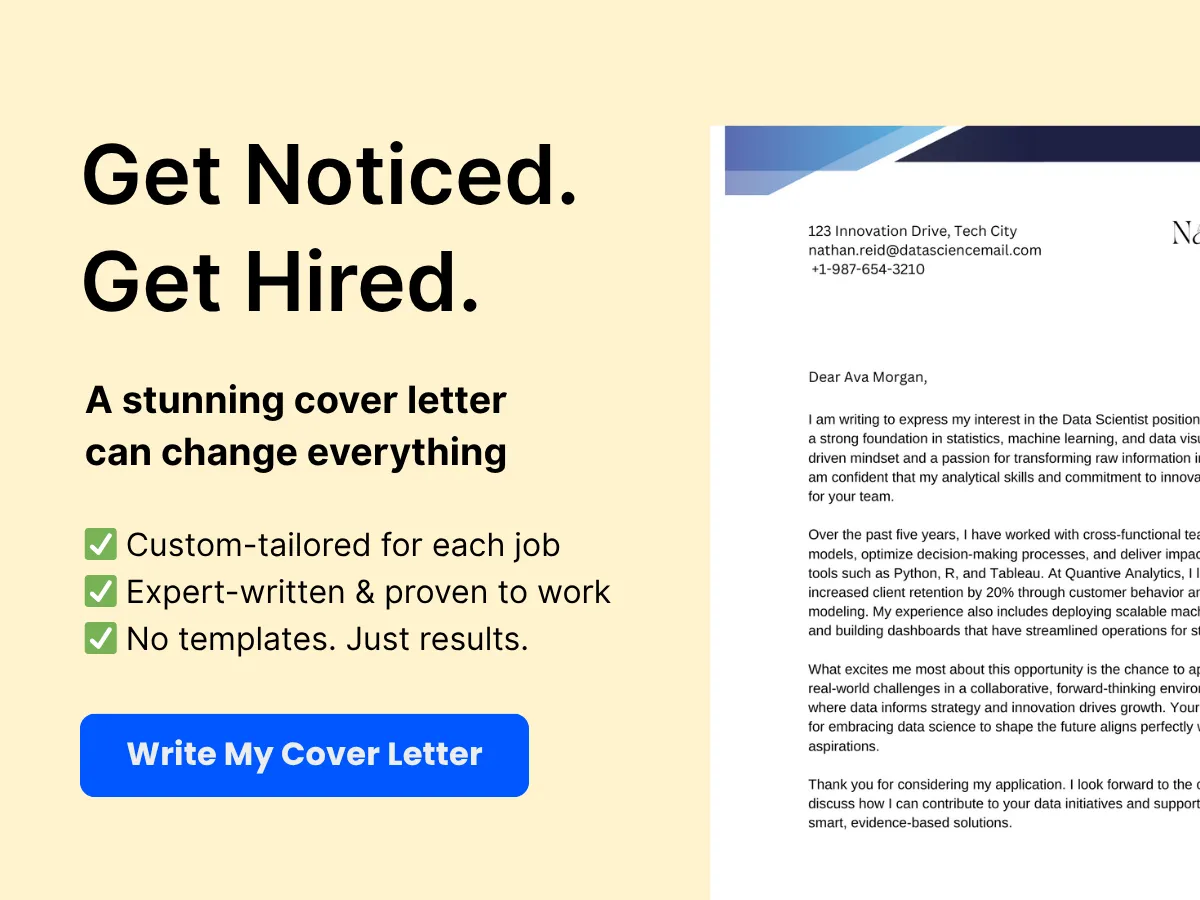In the world of written communication, the closing of a letter is often an overlooked yet crucial element that can leave a lasting impression on the recipient. Whether you are writing a heartfelt note to a friend, a formal business correspondence, or a casual email, the way you conclude your message can significantly influence how your words are perceived. Choosing the right letter closing not only reflects your tone and intent but also reinforces your relationship with the reader.
Mastering professional communication, including how to close a letter, can play a key role in career development—especially when paired with a polished professional CV or a tailored cover letter. These elements work together to help convey credibility and clarity in both job applications and workplace correspondence.
This guide explores 30 letter closings suitable for various contexts, from formal emails to personal notes. You will discover how to match your closing to the tone of your message and the nature of your relationship with the recipient. Whether you aim to express warmth, maintain professionalism, or leave a strong final impression, these examples will help enhance your written communication. For those navigating their career path, aligning your messaging strategy with career planning and consulting can further strengthen your personal brand.
Join us as we navigate the nuances of letter closings, providing you with the insights and examples you need to elevate your correspondence and make every message count.
Formal Letter Closings
Definition and Context
Formal letter closings are the concluding phrases used to sign off a letter in a professional or official context. They serve as a polite way to end your correspondence, reflecting the tone and nature of the communication. The choice of closing can convey respect, professionalism, and the relationship between the sender and the recipient. In formal writing, it is essential to choose a closing that aligns with the overall tone of the letter, whether it is a job application, a business proposal, or a letter of complaint.


Understanding the context in which you are writing is crucial. For instance, a letter to a potential employer may require a more formal closing than a letter to a colleague. The right closing can leave a lasting impression and reinforce the message you wish to convey.
Examples
Sincerely
Sincerely is one of the most commonly used formal closings. It is appropriate for a wide range of professional correspondence, including cover letters, business communications, and formal requests. This closing conveys a sense of honesty and straightforwardness, making it a safe choice for most situations.
Dear Mr. Smith,
Thank you for considering my application for the Marketing Manager position. I look forward to the opportunity to discuss my qualifications further.
Sincerely,
John DoeYours faithfully
Yours faithfully is typically used in formal letters when the recipient’s name is unknown. It is often employed in business letters, especially in the UK. This closing indicates a level of respect and formality, making it suitable for official communications.
Dear Sir or Madam,
I am writing to express my interest in the open position at your company. I believe my skills align well with your needs.
Yours faithfully,
Jane SmithRespectfully
Respectfully is a closing that conveys a high level of regard for the recipient. It is often used in letters to authority figures, such as government officials or senior executives. This closing is appropriate when you want to express deference and professionalism.
Dear Dr. Johnson,
I appreciate your guidance on this matter and look forward to your feedback on my proposal.
Respectfully,
Emily WhiteBest regards
Best regards strikes a balance between formality and warmth. It is suitable for professional correspondence where you have an established relationship with the recipient. This closing is often used in emails and letters to colleagues, clients, or business partners.
Dear Mr. Brown,
I hope this message finds you well. Thank you for your continued support on our project.
Best regards,
Michael GreenYours truly
Yours truly is another versatile closing that can be used in both formal and semi-formal letters. It conveys sincerity and is often used in business letters, especially in the United States. This closing is appropriate when you want to maintain a professional tone while still being personable.


Dear Ms. Taylor,
I appreciate your prompt response to my inquiry. I look forward to working together.
Yours truly,
Sarah JohnsonWhen to Use Formal Closings
Choosing the right formal closing depends on several factors, including the nature of your correspondence, your relationship with the recipient, and the overall tone of your letter. Here are some guidelines to help you decide:
- Professional Context: Use formal closings in business letters, job applications, and official communications. This includes letters to clients, vendors, and colleagues in a professional setting.
- Unknown Recipient: If you do not know the recipient’s name, opt for “Yours faithfully” or “To whom it may concern.” This shows respect and maintains formality.
- Established Relationships: If you have a friendly rapport with the recipient, consider using “Best regards” or “Warm regards” to convey a more personal touch while still being professional.
- Authority Figures: When addressing someone in a position of authority, such as a government official or senior executive, use “Respectfully” or “Yours faithfully” to show deference.
Tips for Formal Letter Closings
To ensure your formal letter closing is effective and appropriate, consider the following tips:
- Match the Tone: Ensure that your closing matches the tone of the letter. If your letter is highly formal, choose a closing that reflects that level of formality.
- Be Consistent: Maintain consistency in your letter. If you start with a formal greeting, follow through with a formal closing. This creates a cohesive and professional appearance.
- Use a Comma: In formal letters, it is standard to follow the closing with a comma. For example, “Sincerely,” or “Yours truly,” followed by your name on the next line.
- Leave Space for Signature: If you are sending a hard copy of the letter, leave space between the closing and your typed name for your signature. This adds a personal touch to your correspondence.
- Consider Cultural Differences: Be aware of cultural differences in letter writing. Some cultures may have specific conventions regarding closings, so it’s essential to adapt your approach accordingly.
By carefully selecting your formal letter closing and following these tips, you can enhance the professionalism of your correspondence and leave a positive impression on your recipients.
Semi-Formal Letter Closings
Definition and Context
Semi-formal letter closings strike a balance between the warmth of informal communication and the professionalism of formal correspondence. They are ideal for situations where you want to maintain a level of professionalism while also conveying a friendly tone. This type of closing is commonly used in business communications, such as emails to colleagues, clients, or partners, as well as in personal letters to acquaintances or friends with whom you have a professional relationship.
Understanding when to use semi-formal closings is crucial. They are appropriate in various contexts, including follow-up emails after meetings, thank-you notes, or any correspondence where you want to express appreciation or maintain a cordial relationship without being overly casual. The key is to ensure that the closing reflects the nature of your relationship with the recipient and the overall tone of your message.


Examples
Best Wishes
The closing “Best wishes” is a versatile option that conveys goodwill and positive sentiments. It is suitable for both personal and professional contexts, making it a great choice when you want to express hope for the recipient’s future endeavors or well-being.
Example:
Dear Sarah,
Thank you for your assistance with the project. Your insights were invaluable, and I appreciate your hard work.
Best wishes,
John
Kind Regards
“Kind regards” is a popular closing that maintains a professional tone while also being warm and approachable. It is often used in business emails and is appropriate for both initial communications and ongoing correspondence.


Example:
Dear Mr. Thompson,
I hope this message finds you well. I wanted to follow up on our last discussion regarding the upcoming project timeline.
Kind regards,
Emily
Warm Regards


Example:
Hi Tom,
I just wanted to say how much I enjoyed our meeting yesterday. It was great to brainstorm ideas together.
Warm regards,
Lisa
Yours Sincerely
“Yours sincerely” is a traditional closing that is often used in formal letters, but it can also fit into semi-formal contexts, especially when addressing someone you respect or when the correspondence is of a serious nature. It conveys a sense of sincerity and professionalism.


Example:
Dear Ms. Johnson,
I appreciate your feedback on my proposal. Your insights have helped me refine my approach.
Yours sincerely,
Michael
When to Use Semi-Formal Closings
Choosing the right closing for your letter or email is essential for conveying the appropriate tone. Here are some scenarios where semi-formal closings are particularly effective:


- Business Correspondence: When communicating with colleagues, clients, or business partners, semi-formal closings help maintain professionalism while fostering a friendly atmosphere.
- Networking: If you are reaching out to someone you met at a networking event or conference, a semi-formal closing can help establish a connection without being too casual.
- Follow-Up Emails: After meetings or interviews, using a semi-formal closing can express gratitude and reinforce your interest in the relationship.
- Thank-You Notes: When sending a thank-you note, a semi-formal closing can convey appreciation while keeping the tone light and friendly.
- Personal Letters: In letters to acquaintances or friends with whom you have a professional relationship, semi-formal closings can strike the right balance between personal and professional.
Tips for Semi-Formal Letter Closings
To ensure your semi-formal letter closings are effective, consider the following tips:
- Know Your Audience: Tailor your closing to the recipient’s personality and your relationship with them. If you know the person well, a warmer closing may be appropriate.
- Match the Tone: Ensure that your closing aligns with the overall tone of your message. If your letter is more formal, opt for a closing like “Yours sincerely.” If it’s more casual, “Warm regards” may be a better fit.
- Be Consistent: If you start your letter with a semi-formal greeting, maintain that tone throughout the letter and in your closing. Consistency helps reinforce the message you want to convey.
- Keep It Simple: Avoid overly complex or flowery language in your closing. Simple and straightforward closings are often the most effective.
- Use a Comma: In most cases, a comma should follow your closing phrase. For example, “Best wishes,” or “Kind regards,” followed by your name.
By understanding the nuances of semi-formal letter closings and applying these tips, you can enhance your written communication, making it more effective and engaging. Whether you’re writing a business email or a personal note, the right closing can leave a lasting impression on your reader.
Informal Letter Closings
Definition and Context
Informal letter closings are friendly and casual ways to end a letter, email, or note. They are typically used in personal correspondence, such as letters to friends, family, or acquaintances, where a relaxed tone is appropriate. Unlike formal letter closings, which often adhere to traditional etiquette and structure, informal closings allow for a more personal touch, reflecting the relationship between the sender and the recipient.
In informal communication, the closing serves not only as a way to sign off but also as an opportunity to convey warmth, affection, or camaraderie. The choice of closing can set the tone for the entire message and can even enhance the emotional connection between the sender and the recipient. Understanding when and how to use these informal closings can significantly improve your personal correspondence.
Examples
Cheers
The closing “Cheers” is a popular informal sign-off that conveys a sense of friendliness and positivity. It is often used among friends or colleagues and can be appropriate in both written and spoken communication. This closing is particularly common in British English but has gained popularity in other English-speaking regions as well.
Example:
Hey Sarah,
It was great catching up with you last weekend! Let’s do it again soon.
Cheers,
Emily
Take Care
“Take care” is a warm and caring closing that expresses concern for the recipient’s well-being. It is suitable for letters to friends, family, or anyone with whom you share a close relationship. This closing conveys a sense of affection and can be particularly comforting in times of difficulty or stress.
Example:
Hi John,
I hope you’re doing well! I just wanted to check in and see how everything is going with your new job.
Take care,
Lisa
See You Soon
“See you soon” is an optimistic and friendly closing that implies a future meeting or interaction. It is perfect for letters to friends or family members with whom you have plans to meet again. This closing not only expresses excitement about the next encounter but also reinforces the bond between the sender and the recipient.
Example:
Dear Mike,
I had such a great time at the concert last night! Let’s plan another outing soon.
See you soon,
Anna
Love
The closing “Love” is one of the most affectionate ways to end a letter, typically reserved for close family members or romantic partners. It conveys deep feelings of care and connection, making it a powerful way to express your emotions. This closing is often used in letters to parents, siblings, or significant others.
Example:
Hey Mom,
Thank you for the care package! It made my week so much brighter. I can’t wait to see you next month.
Love,
Jessica
Yours
“Yours” is a versatile informal closing that can be used in various contexts. It strikes a balance between casual and slightly formal, making it suitable for letters to friends, acquaintances, or even colleagues with whom you have a friendly rapport. This closing can be adapted to fit different relationships by adding a modifier, such as “Yours truly” or “Yours always.”
Example:
Hi Tom,
I really enjoyed our chat last week! Let’s keep in touch and plan something soon.
Yours,
Rachel
When to Use Informal Closings
Choosing the right closing for your letter is essential to convey the appropriate tone and sentiment. Informal closings are best used in the following situations:
- Personal Relationships: Use informal closings when writing to friends, family, or close acquaintances. These closings help to reinforce the personal connection and create a warm atmosphere.
- Casual Contexts: If the overall tone of your letter is light-hearted or casual, an informal closing will complement the message effectively.
- Familiarity: When you have an established relationship with the recipient, informal closings can enhance the sense of intimacy and familiarity.
- Emotional Expression: If you want to convey affection, care, or warmth, informal closings like “Love” or “Take care” can help express those feelings more effectively.
Tips for Informal Letter Closings
When using informal letter closings, consider the following tips to ensure your message is well-received:
- Know Your Audience: Tailor your closing to the recipient’s personality and your relationship with them. A close friend may appreciate a more casual closing, while a distant relative might prefer something slightly more reserved.
- Match the Tone: Ensure that your closing matches the overall tone of your letter. If your letter is light and cheerful, an upbeat closing like “Cheers” or “See you soon” is appropriate. Conversely, if your letter is more serious, consider a closing like “Take care” or “Yours.”
- Be Authentic: Choose a closing that feels natural to you. Authenticity is key in informal communication, so select a closing that reflects your personality and the nature of your relationship with the recipient.
- Consider Cultural Differences: Be mindful of cultural variations in letter closings. What may be considered informal and friendly in one culture could be perceived differently in another. When writing to someone from a different cultural background, it’s wise to research appropriate closings.
- Use Modifiers Wisely: You can enhance informal closings by adding modifiers that reflect your feelings or the context of your message. For example, “Much love,” “All the best,” or “Warm regards” can add a personal touch.
Professional Letter Closings
In the realm of professional communication, the closing of a letter is just as important as its opening. A well-chosen closing not only reinforces the tone of your message but also leaves a lasting impression on the recipient. This section delves into the definition and context of professional letter closings, provides examples, discusses when to use them, and offers tips for crafting the perfect closing.
Definition and Context
Professional letter closings are the final words or phrases that precede your signature in a letter or email. They serve to summarize the tone of your correspondence and can convey respect, gratitude, or a call to action. The choice of closing can vary based on the relationship between the sender and recipient, the formality of the communication, and the overall message being conveyed. Understanding the nuances of different closings can enhance your professional image and ensure effective communication.
Examples
Here are some common professional letter closings, along with explanations of their appropriate usage:
Regards
Usage: “Regards” is a versatile closing that strikes a balance between formality and friendliness. It is suitable for most professional communications, whether you are writing to a colleague, a client, or a supervisor.
Example:
Thank you for your assistance with the project. I look forward to your feedback.
Regards,
John Doe
Best
Usage: “Best” is a slightly more casual alternative to “Regards.” It conveys warmth and friendliness while still maintaining professionalism. This closing is ideal for emails or letters to colleagues or clients with whom you have a good rapport.
Example:
I appreciate your insights during our last meeting. Let’s catch up soon.
Best,
Jane Smith
Thank you
Usage: “Thank you” is a powerful closing that expresses gratitude. It is particularly effective when you are requesting assistance, acknowledging support, or following up on a favor. This closing can be used in both formal and informal contexts.
Example:
Thank you for considering my application. I look forward to the opportunity to discuss my qualifications further.
Thank you,
Emily Johnson
With appreciation
Usage: “With appreciation” is a more formal way to express gratitude. It is suitable for situations where you want to convey a deeper sense of thanks, such as after receiving a significant favor or support from a superior or client.
Example:
Your guidance has been invaluable to my professional development. I truly appreciate your support.
With appreciation,
Michael Brown
Yours respectfully
Usage: “Yours respectfully” is a formal closing that conveys a high level of respect for the recipient. It is often used in letters to superiors, clients, or in situations where the relationship is more hierarchical. This closing is appropriate for formal business letters, cover letters, or any correspondence that requires a respectful tone.
Example:
I am grateful for the opportunity to present my ideas to you. Thank you for your consideration.
Yours respectfully,
Sarah Williams
When to Use Professional Closings
Choosing the right professional closing depends on several factors:
- Relationship with the Recipient: Consider your relationship with the person you are addressing. If you have a close working relationship, a more casual closing like “Best” may be appropriate. Conversely, if you are writing to someone you do not know well or a higher-up, opt for a more formal closing like “Yours respectfully.”
- Context of the Communication: The nature of your message also dictates the closing. For instance, if you are expressing gratitude, “Thank you” or “With appreciation” would be fitting. If you are simply concluding a routine update, “Regards” or “Best” would suffice.
- Formality of the Situation: In formal business settings, it is advisable to err on the side of caution. Use more traditional closings in formal letters, while you can be more relaxed in emails or informal communications.
Tips for Professional Letter Closings
To ensure your letter closing is effective and appropriate, consider the following tips:
- Match the Tone: Ensure that your closing matches the tone of the rest of your letter. If your letter is formal, your closing should be as well. Conversely, if your letter is friendly and informal, a casual closing is more suitable.
- Be Consistent: Maintain consistency in your communication style. If you start with a formal greeting, it’s best to end with a formal closing. This consistency reinforces your professionalism.
- Keep It Simple: Avoid overly complex or flowery closings. Simple and straightforward closings are often the most effective. They convey your message clearly without unnecessary embellishment.
- Consider Cultural Differences: If you are communicating with someone from a different cultural background, be aware that letter closings may vary in formality and appropriateness. Researching cultural norms can help you choose a suitable closing.
- Proofread: Always proofread your letter before sending it. A closing that contains a typo or grammatical error can undermine your professionalism. Ensure that your closing is polished and error-free.
The closing of a professional letter is a critical component of effective communication. By understanding the context, choosing the right closing, and following best practices, you can enhance your professional image and foster positive relationships through your written correspondence.
Creative and Unique Letter Closings
In the world of letter writing, the closing is just as important as the opening. It serves as the final touch, leaving a lasting impression on the reader. While traditional closings like “Sincerely” or “Best regards” are widely accepted, there’s a growing trend towards more creative and unique letter closings that can add a personal flair to your correspondence. This section explores the definition and context of creative letter closings, provides examples, discusses when to use them, and offers tips for crafting your own unique sign-offs.
Definition and Context
Creative letter closings are unconventional sign-offs that reflect the personality of the writer and the nature of the relationship with the recipient. Unlike standard closings, which can sometimes feel impersonal or formulaic, creative closings can convey warmth, humor, or a sense of adventure. They are particularly effective in personal letters, informal business communications, or any situation where you want to stand out and leave a memorable impression.
Using a creative closing can also help to reinforce the tone of your message. For instance, if you’ve written a light-hearted letter, a whimsical closing can enhance that tone. Conversely, if your letter is more serious, a thoughtful or reflective closing can provide a fitting conclusion. The key is to ensure that your closing aligns with the overall message and sentiment of your letter.
Examples
Here are some creative and unique letter closings that you can use to add a personal touch to your correspondence:
- Stay awesome – This closing is perfect for friends or colleagues with whom you share a casual relationship. It conveys positivity and encouragement, making it a great way to end a friendly note.
- Keep shining – Ideal for someone who is going through a tough time or is on the verge of a new opportunity, this closing is uplifting and supportive. It encourages the recipient to continue being their best self.
- To infinity and beyond – A playful nod to the famous phrase from the movie “Toy Story,” this closing is suitable for friends, family, or anyone who appreciates a bit of humor. It adds a whimsical touch to your letter.
- Yours in adventure – This closing is perfect for travel enthusiasts or those who share a love for exploration. It conveys a sense of camaraderie and excitement, making it a great choice for friends or fellow adventurers.
- With gratitude – While slightly more traditional, this closing can be made unique by the context in which it is used. It’s perfect for expressing appreciation, whether in a personal letter or a thank-you note.
When to Use Creative Closings
Choosing the right closing depends on several factors, including the relationship with the recipient, the tone of the letter, and the context of the communication. Here are some scenarios where creative closings can be particularly effective:
- Personal Letters: When writing to friends or family, feel free to use creative closings that reflect your personality and the nature of your relationship. This is your opportunity to be informal and express your individuality.
- Informal Business Communications: In a less formal business setting, such as a friendly email to a colleague or a thank-you note to a client, a creative closing can help to build rapport and foster a positive relationship.
- Thank-You Notes: When expressing gratitude, a unique closing can enhance the sincerity of your message. It shows that you put thought into your correspondence and appreciate the recipient’s efforts.
- Invitations or Event Announcements: If you’re sending out invitations or announcements for a fun event, a creative closing can set the tone and excite the recipient about what’s to come.
- Letters of Encouragement: When writing to someone who may need a boost, a positive and uplifting closing can reinforce your message of support and encouragement.
Tips for Creative Letter Closings
Crafting a unique letter closing requires a blend of creativity and consideration. Here are some tips to help you develop your own creative sign-offs:
- Know Your Audience: Always consider the recipient when choosing a closing. What might be appropriate for a close friend may not be suitable for a professional contact. Tailor your closing to fit the relationship.
- Reflect Your Personality: Your closing should be a reflection of who you are. If you have a quirky sense of humor, don’t hesitate to incorporate that into your sign-off. Authenticity resonates with readers.
- Match the Tone: Ensure that your closing aligns with the overall tone of your letter. If your letter is serious, a light-hearted closing may feel out of place. Conversely, if your letter is upbeat, a more formal closing might dampen the mood.
- Be Mindful of Context: Consider the context of your letter. For example, if you’re writing a letter of resignation, a creative closing may not be appropriate. Use your judgment to determine what fits the situation.
- Experiment and Have Fun: Don’t be afraid to try out different closings. Experimenting with various phrases can help you find what feels right for you. The more you practice, the more natural it will become.
Incorporating creative and unique letter closings into your correspondence can elevate your writing and leave a lasting impression. By choosing the right closing for the occasion and reflecting your personality, you can enhance your communication and strengthen your connections with others.
Letter Closings for Special Occasions
Letter closings are an essential part of any correspondence, serving as the final touch that conveys your sentiments and intentions. When it comes to special occasions, the right closing can enhance the emotional impact of your message, making it more memorable and meaningful. We will explore various letter closings tailored for special occasions, providing examples, context, and tips for their effective use.
Definition and Context
Special occasion letter closings are phrases used to conclude letters that celebrate or acknowledge significant events in life. These events can range from holidays and weddings to graduations and condolences. The choice of closing should reflect the nature of the occasion and the relationship between the sender and the recipient. A well-chosen closing not only wraps up your message but also reinforces the emotions you wish to convey, whether it be joy, sympathy, or congratulations.
Examples
Happy Holidays
“Happy Holidays” is a versatile closing that can be used in letters sent during the festive season. It conveys warmth and goodwill, making it suitable for both personal and professional correspondence.
Example: “Wishing you and your family a joyful holiday season. Happy Holidays!”
Warmest Wishes
This closing is perfect for expressing heartfelt sentiments. It can be used in various contexts, from personal letters to more formal communications, and is especially fitting for occasions like weddings or anniversaries.
Example: “As you embark on this beautiful journey together, I send you my warmest wishes for a lifetime of love and happiness.”
Congratulations
When celebrating achievements, such as graduations, promotions, or new ventures, a simple “Congratulations” can be a powerful closing. It acknowledges the recipient’s success and adds a personal touch to your message.
Example: “Congratulations on your well-deserved promotion! I’m so proud of you.”
Best of Luck
This closing is ideal for letters wishing someone success in their future endeavors, whether it’s a new job, a move, or any significant life change. It conveys support and encouragement.
Example: “As you start this new chapter in your life, I wish you the best of luck in all your endeavors!”
With Deepest Sympathy
In times of loss, a closing that expresses sympathy is crucial. “With deepest sympathy” conveys compassion and understanding, making it appropriate for condolence letters.
Example: “Please accept my heartfelt condolences for your loss. With deepest sympathy.”
When to Use Special Occasion Closings
Choosing the right closing for a special occasion depends on several factors, including the nature of the event, your relationship with the recipient, and the tone of your letter. Here are some guidelines to help you determine when to use special occasion closings:
- Consider the Occasion: Different occasions call for different tones. For joyous events like weddings or graduations, opt for warm and celebratory closings. For somber events like funerals, choose closings that reflect compassion and support.
- Know Your Audience: Tailor your closing to the recipient. A close friend may appreciate a more casual and heartfelt closing, while a colleague or acquaintance might prefer something more formal.
- Match the Tone of Your Letter: Ensure that your closing aligns with the overall tone of your letter. If your letter is light-hearted and cheerful, your closing should reflect that sentiment. Conversely, if your letter is serious or reflective, choose a closing that matches that mood.
- Be Authentic: Your closing should feel genuine. Use phrases that resonate with your personal style and the relationship you have with the recipient. Authenticity fosters connection and makes your message more impactful.
Tips for Special Occasion Letter Closings
To ensure your letter closings for special occasions are effective and appropriate, consider the following tips:
- Personalize Your Message: Whenever possible, personalize your closing to reflect your relationship with the recipient. Adding a personal touch, such as a shared memory or inside joke, can make your message more meaningful.
- Keep It Simple: While it’s important to convey your sentiments, simplicity often works best. A straightforward closing can be just as powerful as a more elaborate one.
- Use Appropriate Punctuation: The punctuation you choose can affect the tone of your closing. For example, an exclamation mark can convey enthusiasm, while a period may lend a more serious tone. Choose punctuation that aligns with your message.
- Consider the Format: If you’re sending a handwritten letter, your closing should match the overall aesthetic of your letter. For digital correspondence, ensure your closing fits the format and style of your email or message.
- Practice Good Etiquette: In formal situations, it’s essential to adhere to etiquette. Use appropriate titles and avoid overly casual language unless you have a close relationship with the recipient.
Special occasion letter closings play a vital role in conveying your sentiments and enhancing the emotional impact of your message. By choosing the right closing for the occasion and personalizing it to fit your relationship with the recipient, you can create a lasting impression that resonates long after the letter is read.
Cultural Considerations in Letter Closings
When it comes to letter writing, the closing is just as important as the opening. It serves as the final impression you leave with your reader, and in a globalized world, understanding cultural nuances in letter closings is essential. This section delves into the importance of cultural sensitivity, provides examples of culturally appropriate closings, and offers tips for effective cross-cultural communication.
Importance of Cultural Sensitivity
Cultural sensitivity in communication is crucial, especially in written correspondence. Different cultures have varying norms and expectations regarding how to express respect, warmth, and professionalism. A closing that is perfectly acceptable in one culture may be perceived as overly formal, too casual, or even disrespectful in another.
For instance, in some cultures, using a first name in a closing may be seen as friendly and approachable, while in others, it could be interpreted as a lack of respect. Understanding these differences can help avoid misunderstandings and foster better relationships, whether in personal correspondence or professional settings.
Moreover, demonstrating cultural awareness can enhance your credibility and show that you value the recipient’s background and traditions. This is particularly important in international business communications, where a thoughtful closing can set the tone for future interactions.
Examples of Culturally Appropriate Closings
Here are some examples of letter closings that are culturally appropriate for various regions and contexts:
- United States: Common closings include “Sincerely,” “Best regards,” and “Warm regards.” These are generally safe choices for both formal and informal letters.
- United Kingdom: “Yours sincerely” is often used in formal letters when the recipient’s name is known, while “Yours faithfully” is used when the recipient’s name is unknown. For informal letters, “Best wishes” or “Cheers” can be appropriate.
- Japan: In Japanese correspondence, it is customary to use “??” (Keigu) at the end of formal letters, which translates to “respectfully yours.” In more casual settings, “??????????” (Yoroshiku onegaishimasu) can be used, meaning “I humbly request your favor.”
- Germany: “Mit freundlichen Grüßen” (With friendly greetings) is a standard closing for formal letters. For informal correspondence, “Liebe Grüße” (Dear greetings) is often used among friends.
- France: “Cordialement” (Cordially) is a common closing for professional letters, while “Amitiés” (Friendship) is suitable for informal letters among friends.
- Spain: “Atentamente” (Sincerely) is appropriate for formal letters, while “Un abrazo” (A hug) can be used in more casual correspondence.
- China: In formal letters, “??” (Ci zhì) followed by “??” (Jìng li) translates to “Herewith, respectfully.” In informal contexts, “??” (Zhù hao) meaning “Wishing you well” is often used.
These examples illustrate the diversity in letter closings across cultures. When writing to someone from a different cultural background, it’s essential to choose a closing that aligns with their customs and expectations.
Tips for Cross-Cultural Communication
Effective cross-cultural communication requires more than just understanding letter closings. Here are some tips to enhance your communication skills when writing letters to individuals from different cultures:
1. Research Cultural Norms
Before writing a letter, take the time to research the cultural norms of the recipient. Understanding their communication style, including how they prefer to be addressed and the level of formality they expect, can help you craft a more appropriate closing.
2. Use Neutral Language
When in doubt, opt for neutral language that is widely accepted across cultures. Closings like “Best regards” or “Sincerely” are generally safe choices that convey professionalism without being overly familiar.
3. Avoid Slang and Idioms
Slang and idiomatic expressions may not translate well across cultures and can lead to confusion. Stick to clear and straightforward language to ensure your message is understood.
4. Be Mindful of Titles and Hierarchies
In many cultures, titles and hierarchies play a significant role in communication. Addressing someone by their title (e.g., Dr., Professor, Mr., Ms.) can show respect and acknowledgment of their position. Ensure that your closing reflects this understanding.
5. Personalize When Appropriate
If you have a closer relationship with the recipient, consider personalizing your closing. A simple “Looking forward to hearing from you” or “Take care” can add warmth to your message, provided it aligns with the recipient’s cultural expectations.
6. Seek Feedback
If you frequently communicate with individuals from different cultures, consider seeking feedback on your correspondence. This can help you refine your approach and better understand how your closings are perceived.
7. Be Open to Learning
Cultural norms are not static; they evolve over time. Stay open to learning about different cultures and their communication styles. This willingness to adapt will enhance your effectiveness in cross-cultural communication.
Understanding cultural considerations in letter closings is vital for effective communication. By being culturally sensitive and choosing appropriate closings, you can foster better relationships and avoid potential misunderstandings. Whether you are writing a formal business letter or a casual note to a friend, taking the time to consider cultural nuances will enhance your correspondence and demonstrate respect for the recipient’s background.
Common Mistakes to Avoid
When it comes to letter closings, the final impression you leave can be just as important as the content of your message. Choosing the right closing can enhance your communication, while the wrong choice can lead to misunderstandings or a lack of professionalism. Here, we will explore some common mistakes people make when selecting letter closings and provide tips on how to avoid them.
Overly Casual Closings in Formal Contexts
One of the most frequent errors in letter writing is using overly casual closings in formal contexts. While it may be tempting to sign off with a friendly “Cheers” or “Take care,” these closings can undermine the seriousness of your message, especially in professional or business communications.
For instance, if you are writing a cover letter to a potential employer, a closing like “Best wishes” or “See you soon” may come off as too informal. Instead, opt for more traditional closings such as “Sincerely,” “Best regards,” or “Yours faithfully.” These options convey respect and professionalism, which are crucial in formal correspondence.
Consider the context of your letter. If you are addressing a colleague you know well, a casual closing might be acceptable. However, if you are writing to a client, supervisor, or someone you do not know personally, err on the side of formality. Remember, the goal is to maintain a tone that reflects the nature of your relationship and the subject matter of your letter.
Misusing Formal Closings in Informal Contexts
On the flip side, misusing formal closings in informal contexts can also create a disconnect. If you are writing to a friend or a family member, using a closing like “Yours sincerely” or “Respectfully yours” can come off as stiff and overly formal. This can make your letter feel less personal and more like a business transaction.
For example, if you are sending a birthday card to a close friend, a closing such as “With love” or “Warmly” would be more appropriate. These closings convey warmth and affection, which are essential in personal communications. Using overly formal closings in these situations can create a barrier and make your message feel less genuine.
To avoid this mistake, consider your relationship with the recipient and the purpose of your letter. If the tone of your message is light-hearted or casual, choose a closing that reflects that sentiment. This will help you maintain a friendly and approachable tone throughout your correspondence.
Overly Creative Closings in Professional Settings
In an effort to stand out or express creativity, some individuals may opt for overly creative or quirky closings in professional settings. While creativity can be a valuable asset in many fields, it is essential to recognize when it is appropriate to showcase it. Using a closing like “Stay awesome” or “Keep shining” in a business letter can come across as unprofessional and may not be well-received by the recipient.
For example, if you are writing a proposal to a potential client, a creative closing may detract from the seriousness of your message. Instead, stick to conventional closings that convey professionalism and respect, such as “Thank you for your consideration” or “Looking forward to your response.” These closings maintain the integrity of your message while still allowing you to express your enthusiasm.
When in doubt, it is better to err on the side of caution. If you are unsure whether a creative closing is appropriate, consider the industry norms and the recipient’s expectations. In most professional settings, traditional closings are the safest bet.
Tips for Avoiding Common Mistakes
To help you navigate the complexities of letter closings and avoid common pitfalls, here are some practical tips:
- Know Your Audience: Understanding your audience is crucial. Consider their preferences, the nature of your relationship, and the context of your communication. Tailor your closing accordingly.
- Match the Tone: Ensure that your closing matches the tone of your letter. If your message is formal, choose a closing that reflects that formality. Conversely, if your letter is casual, opt for a more relaxed closing.
- Stay Consistent: Maintain consistency in your letter. If you start with a formal tone, don’t switch to a casual closing. Consistency helps reinforce your message and keeps the reader engaged.
- Consider the Industry: Different industries have varying standards for communication. Research the norms within your field to ensure your closing aligns with industry expectations.
- Practice Makes Perfect: The more you write, the more comfortable you will become with selecting appropriate closings. Practice writing letters in different contexts to hone your skills.
- Seek Feedback: If you are unsure about your closing, consider seeking feedback from a trusted colleague or friend. They can provide valuable insights and help you refine your approach.
By being mindful of these common mistakes and following the tips provided, you can enhance your letter writing skills and ensure that your closings leave a positive and lasting impression. Remember, the way you close your letter can significantly impact how your message is received, so choose wisely!
Customizing Your Letter Closing
When it comes to letter writing, the closing is just as important as the opening and body. A well-crafted closing can leave a lasting impression, convey your sentiments effectively, and reinforce the overall tone of your message. Customizing your letter closing is essential to ensure it resonates with your audience, matches the tone of your letter, and feels personal. We will explore how to tailor your letter closing to fit various contexts and relationships.
Exploring Your Audience
Understanding your audience is the first step in customizing your letter closing. The way you close a letter can vary significantly depending on who you are addressing. Consider the following factors:
- Relationship: Are you writing to a friend, a colleague, a client, or a superior? The nature of your relationship will dictate the level of formality required in your closing.
- Context: Is this a personal letter, a business correspondence, or a formal invitation? The context will influence the tone and style of your closing.
- Culture: Different cultures have varying norms regarding letter closings. Be mindful of cultural differences that may affect how your closing is perceived.
By taking the time to understand your audience, you can choose a closing that feels appropriate and respectful, enhancing the overall effectiveness of your communication.
Matching the Tone of Your Letter
The tone of your letter should be consistent from the opening to the closing. Whether your letter is formal, informal, friendly, or professional, your closing should reflect that tone. Here are some tips for matching the tone:
- Formal Letters: For formal letters, such as job applications or business communications, use closings that convey professionalism. Examples include “Sincerely,” “Best regards,” or “Yours faithfully.”
- Informal Letters: In informal letters to friends or family, you can adopt a more casual tone. Consider closings like “Love,” “Cheers,” or “Take care.”
- Friendly Yet Professional: If you are writing to a colleague or a client with whom you have a friendly relationship, you can strike a balance with closings like “Warm regards,” “Best wishes,” or “Kind regards.”
By ensuring that your closing matches the tone of your letter, you create a cohesive message that feels intentional and well thought out.
Personalizing Your Closing
Personalization is key to making your letter feel genuine and heartfelt. A personalized closing can strengthen your connection with the recipient and leave a positive impression. Here are some strategies for personalizing your closing:
- Use the Recipient’s Name: Instead of a generic closing, consider incorporating the recipient’s name. For example, “Warm regards, [Your Name]” can be more impactful than simply “Warm regards.”
- Reference Shared Experiences: If you have a shared experience or inside joke with the recipient, referencing it in your closing can add a personal touch. For instance, “Looking forward to our next coffee catch-up!”
- Express Gratitude: If your letter is a thank-you note or expresses appreciation, make sure your closing reflects that sentiment. Phrases like “With heartfelt thanks,” or “Gratefully yours,” can enhance the personal touch.
Personalizing your closing not only makes your letter more memorable but also shows that you value the relationship with the recipient.
Examples of Customized Closings
To help you navigate the world of letter closings, here are some examples tailored to different audiences and contexts:
Formal Closings
- Sincerely: A classic choice for formal letters, suitable for business correspondence and job applications.
- Yours faithfully: Often used in formal letters when the recipient’s name is unknown.
- Best regards: A professional yet slightly warmer option, ideal for business emails and letters.
- Respectfully: Appropriate for letters to superiors or in situations requiring deference.
Informal Closings
- Love: Perfect for letters to family members or close friends.
- Cheers: A casual and friendly closing, great for informal correspondence.
- Take care: A warm and caring way to close a letter to someone you know well.
- See you soon: Ideal for letters to friends or acquaintances with whom you have plans to meet.
Friendly Yet Professional Closings
- Warm regards: A versatile closing that works well in both professional and friendly contexts.
- Best wishes: Suitable for letters that are friendly but still maintain a level of professionalism.
- Kind regards: A polite and friendly closing that is appropriate for business communications.
- Looking forward to hearing from you: A closing that encourages a response while remaining professional.
Personalized Closings
- With heartfelt thanks, [Your Name]: A great choice for thank-you letters.
- Excited for our next adventure, [Your Name]: Perfect for letters to friends or family about upcoming plans.
- Until next time, [Your Name]: A friendly and casual way to close a letter to someone you regularly communicate with.
- Wishing you all the best, [Your Name]: A warm and supportive closing that can be used in various contexts.
By customizing your letter closing, you can enhance the effectiveness of your communication and leave a positive impression on your recipient. Whether you choose a formal, informal, or personalized closing, the key is to ensure it aligns with your audience and the tone of your letter. With these strategies and examples, you can confidently craft the perfect closing for any occasion.
Choosing the right letter closing is essential for effectively conveying your message and maintaining the appropriate tone. This article provides a comprehensive guide to various types of letter closings, ensuring you can select the perfect one for any occasion.
Key Takeaways
- Understand the Context: Different situations call for different tones. Familiarize yourself with formal, semi-formal, informal, professional, and creative closings to match your letter’s intent.
- Formal Closings: Use closings like “Sincerely” or “Yours faithfully” in professional or official correspondence to convey respect and seriousness.
- Semi-Formal Closings: Opt for “Best wishes” or “Kind regards” when writing to acquaintances or colleagues, striking a balance between professionalism and warmth.
- Informal Closings: Use casual closings like “Cheers” or “Love” with friends and family to express familiarity and affection.
- Professional Closings: Phrases like “Thank you” or “With appreciation” are ideal for business communications, showing gratitude and respect.
- Creative Closings: Stand out with unique closings such as “Stay awesome” or “To infinity and beyond” when appropriate, especially in personal or creative contexts.
- Special Occasion Closings: Tailor your closing for specific events, using phrases like “Happy holidays” or “With deepest sympathy” to convey the right sentiment.
- Cultural Sensitivity: Be aware of cultural differences in letter closings to ensure respectful and effective communication across diverse audiences.
- Avoid Common Mistakes: Steer clear of overly casual or inappropriate closings for the context to maintain professionalism and clarity.
- Customize Your Closing: Personalize your letter closing based on your audience and the tone of your message to enhance connection and engagement.
In conclusion, mastering the art of letter closings can significantly enhance your communication skills. By understanding the context and audience, you can choose a closing that not only fits the occasion but also reflects your personal style. Don’t hesitate to experiment with different closings to find what resonates best with you and your recipients.








